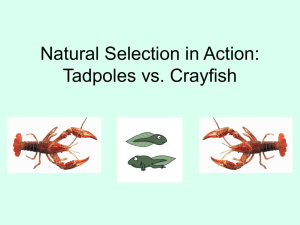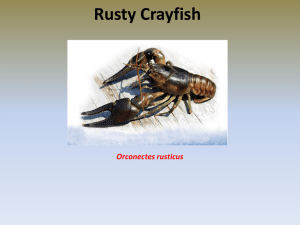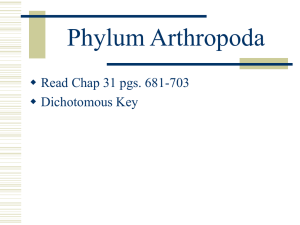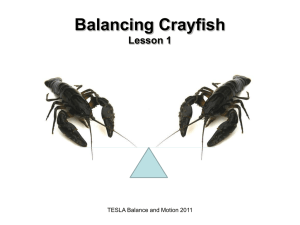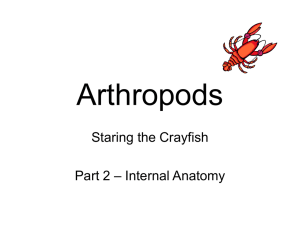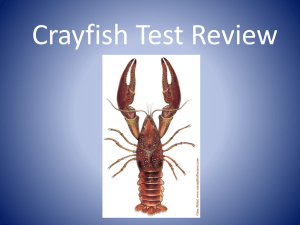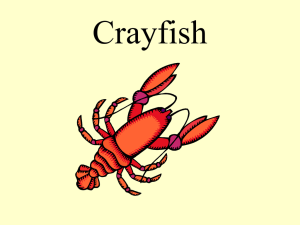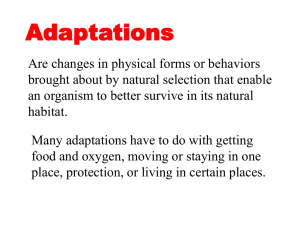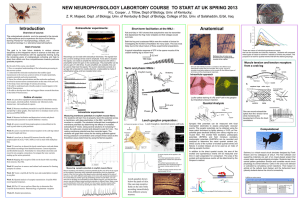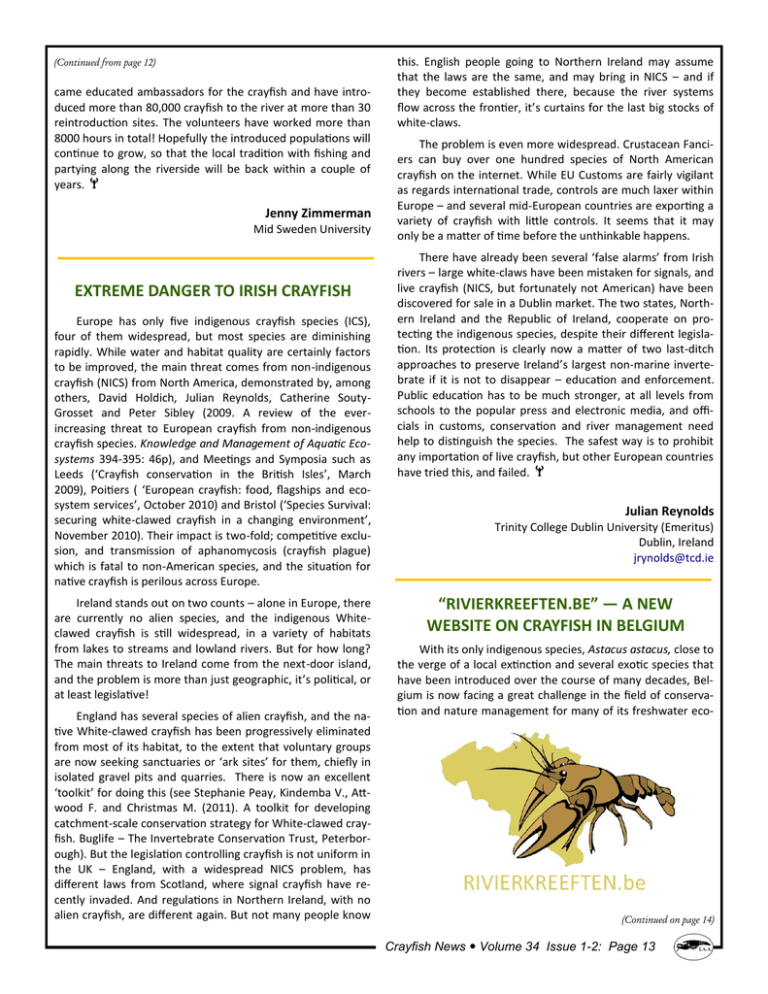
(Continued from page 12)
came educated ambassadors for the crayfish and have introduced more than 80,000 crayfish to the river at more than 30
reintroduction sites. The volunteers have worked more than
8000 hours in total! Hopefully the introduced populations will
continue to grow, so that the local tradition with fishing and
partying along the riverside will be back within a couple of
years. H
Jenny Zimmerman
Mid Sweden University
EXTREME DANGER TO IRISH CRAYFISH
Europe has only five indigenous crayfish species (ICS),
four of them widespread, but most species are diminishing
rapidly. While water and habitat quality are certainly factors
to be improved, the main threat comes from non-indigenous
crayfish (NICS) from North America, demonstrated by, among
others, David Holdich, Julian Reynolds, Catherine SoutyGrosset and Peter Sibley (2009. A review of the everincreasing threat to European crayfish from non-indigenous
crayfish species. Knowledge and Management of Aquatic Ecosystems 394-395: 46p), and Meetings and Symposia such as
Leeds (‘Crayfish conservation in the British Isles’, March
2009), Poitiers ( ‘European crayfish: food, flagships and ecosystem services’, October 2010) and Bristol (‘Species Survival:
securing white-clawed crayfish in a changing environment’,
November 2010). Their impact is two-fold; competitive exclusion, and transmission of aphanomycosis (crayfish plague)
which is fatal to non-American species, and the situation for
native crayfish is perilous across Europe.
Ireland stands out on two counts – alone in Europe, there
are currently no alien species, and the indigenous Whiteclawed crayfish is still widespread, in a variety of habitats
from lakes to streams and lowland rivers. But for how long?
The main threats to Ireland come from the next-door island,
and the problem is more than just geographic, it’s political, or
at least legislative!
England has several species of alien crayfish, and the native White-clawed crayfish has been progressively eliminated
from most of its habitat, to the extent that voluntary groups
are now seeking sanctuaries or ‘ark sites’ for them, chiefly in
isolated gravel pits and quarries. There is now an excellent
‘toolkit’ for doing this (see Stephanie Peay, Kindemba V., Attwood F. and Christmas M. (2011). A toolkit for developing
catchment-scale conservation strategy for White-clawed crayfish. Buglife – The Invertebrate Conservation Trust, Peterborough). But the legislation controlling crayfish is not uniform in
the UK – England, with a widespread NICS problem, has
different laws from Scotland, where signal crayfish have recently invaded. And regulations in Northern Ireland, with no
alien crayfish, are different again. But not many people know
this. English people going to Northern Ireland may assume
that the laws are the same, and may bring in NICS – and if
they become established there, because the river systems
flow across the frontier, it’s curtains for the last big stocks of
white-claws.
The problem is even more widespread. Crustacean Fanciers can buy over one hundred species of North American
crayfish on the internet. While EU Customs are fairly vigilant
as regards international trade, controls are much laxer within
Europe – and several mid-European countries are exporting a
variety of crayfish with little controls. It seems that it may
only be a matter of time before the unthinkable happens.
There have already been several ‘false alarms’ from Irish
rivers – large white-claws have been mistaken for signals, and
live crayfish (NICS, but fortunately not American) have been
discovered for sale in a Dublin market. The two states, Northern Ireland and the Republic of Ireland, cooperate on protecting the indigenous species, despite their different legislation. Its protection is clearly now a matter of two last-ditch
approaches to preserve Ireland’s largest non-marine invertebrate if it is not to disappear – education and enforcement.
Public education has to be much stronger, at all levels from
schools to the popular press and electronic media, and officials in customs, conservation and river management need
help to distinguish the species. The safest way is to prohibit
any importation of live crayfish, but other European countries
have tried this, and failed. H
Julian Reynolds
Trinity College Dublin University (Emeritus)
Dublin, Ireland
jrynolds@tcd.ie
“RIVIERKREEFTEN.BE” — A NEW
WEBSITE ON CRAYFISH IN BELGIUM
With its only indigenous species, Astacus astacus, close to
the verge of a local extinction and several exotic species that
have been introduced over the course of many decades, Belgium is now facing a great challenge in the field of conservation and nature management for many of its freshwater eco-
(Continued on page 14)
Crayfish News Volume 34 Issue 1-2: Page 13
(Continued from page 13)
might be an interesting way to provide an additional income.
systems.
Although four exotic crayfish species thrive in Belgian
water bodies and rivers, almost no information is available on
their current dispersal and the extent of their invasive behavior. Existing sources are often inaccurate, unreliable or outdated, thus making them inadequate to understand the
scope of the exotic crayfish problem in real time.
RIVIERKREEFTEN.be is a new website exclusively devoted
to the freshwater crayfish that occur in Belgium. This initiative reaches out to anyone who shows interest in freshwater
crayfish, and attempts to fill the information void that currently exists on this particular topic. The website provides
basic information on general crayfish biology, the indigenous
and non-indigenous species that occur in Belgium, and the
harm that invasive crayfish are causing to the indigenous fauna and flora. At this moment, the website is only available in
Dutch. Later on, French and English translations will be available.
A new interactive tool will be online starting from September 2012 to add more functionality to the website, enabling visitors to submit observations of wild crayfish with precise information on the encountered species and their locations. This input will hopefully improve the knowledge on the
dispersal of all the freshwater crayfish species in Belgium and
actively support scientific research on this matter. H
Xavier Vermeersch
Vrije Universiteit BrusselGebouw F - Vakgroep Biologie
Pleinlaan 2, 1050 Brussel, Belgium
xavier.vermeersch@vub.ac.be
Thomas Abeel
Katholieke Hogeschool Sint-Lieven
Dept. Agro- & Biotechnologie
Hospitaalstraat 239100 Sint-Niklaas, Belgium
thomas.abeel@kahosl.be
OPPORTUNITIES FOR NOBLE CRAYFISH
PRODUCTION IN BELGIUM
Two University Colleges - KaHo Sint-Lieven (KAHO) and
Hogeschool Universiteit Brussel (HUB) - are investigating
whether production of noble crayfish could be a viable activity for Belgian farmers. Nowadays, many farmers are trying to
diversify their activities, and in this context, crayfish culture
Crayfish News Volume 34 Issue 1-2: Page 14
Unlike in many other European countries, the noble crayfish (Astacus astacus) appears to be a relatively unknown
delicacy to Belgian people. The production of crayfish in Belgium is rather low, and most crayfish for human consumption
are imported.
While the indigenous noble crayfish is known to have a
superior taste, mainly American crayfish (Procambarus clarkii)
are found on the market. Nevertheless, an inquiry by the HUB
showed there’s a potential market for locally produced indigenous crayfish, especially in the sector of star restaurants.
Years ago, top chefs in Belgium frequently used noble
crayfish in their dishes. The low availability of noble crayfish
and the inferior taste of their widely available American
counterparts, caused crayfish to disappear from several restaurant menus. However, noble crayfish are still regarded as
a delicacy by local top chefs, and star restaurants are willing
to reintroduce them on their menus if their availability and
quality could be guaranteed. This fact makes it interesting to
investigate the possibilities for locally produced “Belgian crayfish”.
In order to avoid financial failures, the economic feasibility and technical requirements for noble crayfish production
should first of all be evaluated. Therefore, KAHO and HUB are
now investigating whether noble crayfish culture could become a sustainable aquaculture activity in Belgium or not.
The traditional pond culture doesn‘t seem to be a suited
method to cultivate noble crayfish in Belgium. Due to environmental legislation issues, the lack of suitable agricultural
area and the risk of crayfish plague infection, KAHO decided
to investigate the possibility of producing noble crayfish in
indoor recirculating aquaculture systems (RAS) (Photos 1 – 3).
In its Aquaculture Education and Research Facility (Aqua-ERF)
researchers are looking for the technical requirements to
grow these crayfish to consumption size. An indoor RAS has
the advantage that all kinds of culture parameters including
temperature, water quality and feeding rate can be regulated
and optimized. The production could also be controlled in
order to better meet the market demand (e.g., deliver crayfish outside the normal harvest season). Compared to crayfish culture in ponds or flow-through systems, the prevention
of pathogen introduction will also be more secured in a
closed system.
A financial feasibility study for this type of crayfish production is being carried out by the HUB. Its Trade and Business department will study the market potential of locally
(Continued on page 15)
produced “Belgian crayfish”. They will determine if indoor
crayfish culture can be an economically viable activity in Belgium. Therefore, different parameters will be evaluated, including production costs, the probable demand for locally
produced crayfish and the potential market prices for this
product. Consumer opinion on crayfish as a delicacy will also
be an important factor in this study.
The public attention for this project is quite notable and
farmers have already shown an interest. If the results of this
research turn out to be positive, it seems there will definitely
be candidates to start their own crayfish farm. Hopefully this
project will lead to the establishment of a viable industry,
which can eventually provide Belgian farmers a source of income. H
Thomas Abeel
Katholieke Hogeschool Sint-Lieven
Dept. Agro- & Biotechnologie, Hospitaalstraat 23
9100 Sint-Niklaas, Belgium email:
thomas.abeel@kahosl.be
http://projects.kahosl.be/Aqua-ERF/
Photo 1. The crayfish tanks at the Aqua-ERF research facility.
(Continued from page 19)
Leland JC and Furse JM (2012). Potential utility of haemolymph analysis in non-lethal conservation studies on
threatened Australasian freshwater crayfish: Portability
and practicality. Crustacean Research Special Number
7:87–95.
Lucić A, Hudina S, Faller M and Cerjanec D (2012). A comparative study of the physiological condition of native
and invasive crayfish in Croatian rivers. Biologia
67(1):172–179.
Photo 2. Noble crayfish (in tank) during an optimal density
trial.
Marchi M, Jørgensen SE, Bécares E, Fernández-Aláez C,
Rodríguez C, Fernández-Aláez M, Pulselli FM, Marchettini N and Bastianoni S (2012). Effects of eutrophication and exotic crayfish on health status of two Spanish lakes: A joint application of ecological indicators.
Ecological Indicators 20:92–100.
Martemyanov VI and Mavrin AS (2012). Threshold environmental concentrations of cations defining the range of
roach Rutilus rutilus L. in freshwater reservoirs. Inland
Water Biology 5(1):91–95.
Martin P and Scholtz G (2012). A case of intersexuality in
the parthenogenetic marmorkrebs (Decapoda: Astacida:
Cambaridae). Journal of Crustacean Biology 32(3):345–
350.
Matallanas B, Callejas C and Ochando MD (2012). A genetic approach to spanish populations of the threatened
Austropotamobius italicus located at three different
scenarios. The Scientific World Journal 2012, 975930. H
Photo 3. One summer old noble crayfish in their hiding places
All photos by Thomas Abeel.
Crayfish News Volume 34 Issue 1-2: Page 15

